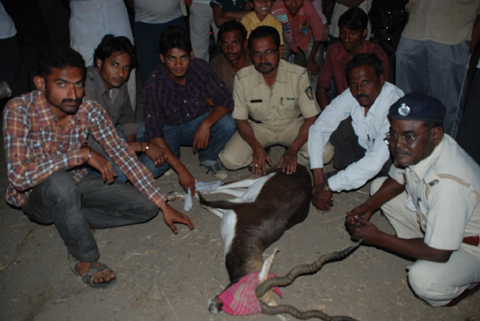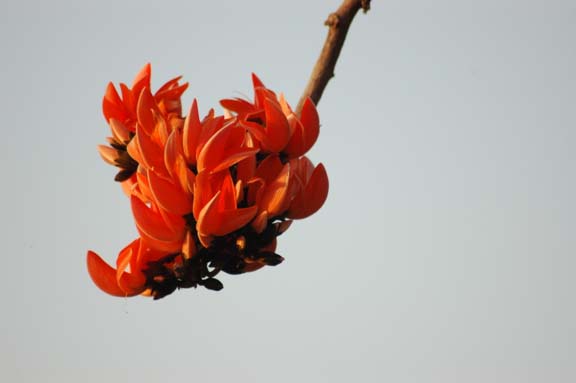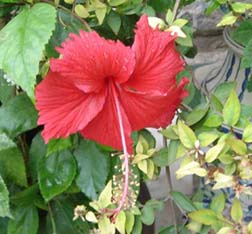Green Defenders
Rescue of black buck
Black buck rescue at Ramtek, a small village of Maharashtra, on the 5th of Feb 2011.
One villager found a black buck in his the agriculture field, black buck was not able to walk. The villagers helped black buck to walk but couldn’t help him out. They called People For Animals Amravati. Mr.Angad Deshmukh, member of PFA Amravati, called forest
department Amravati DFO Mr.Kadam. Help came quickly by means of a rescue vehicle. When they reached there to rescue the black buck now in primary observation by a local vet, it was said to be a case of poisoning.

Vehicle was not able to reach up to the black buck; so the rescue team asked villagers for bullock carts to take black buck out from the agriculture field, but villagers refused. (?)
Finally rescue team members Mr.Angad Deshmukh ,Mr.Bhushan Chaukhande and Mr.Vicky Pohadre pitched in make rescue successfully. DFO Kadam, RFO Kavitkar, helped the rescue team and handed over black buck to Akola forest division for further treatment. Black
buck is protected in the Indian wildlife protection act 1972 under schedule one.
Rescue team said “due to less equipment and facilities and without support of villagers,it’s very difficult to do rescue of animals, as forest department also have very less equipment”. This is a common story in Vidarbha region in Maharashtra which has dry
deciduous forest. The area is plagued by less availability of food and water sources due to deforestation and man-made forest fires. Wild herbivorous migrate toward the agriculture fields in search of food and water. Farmers use insecticide to protect their
crop. Chemical insecticide is very harmful to animals. It is poison to animals when they graze in the agriculture field. The resultant conflict between farmer and wild herbivorous is rising continuously.
There is need to protect forest area, stop illegal grazing inside the forest by villagers.

By-Prajakta Hushangabadkar
[Photos by Angad Deshmukh]
If you know people who are doing same work of rescue and wildlife conservation, you can share their work and achievements with us. So others get motivate to do same job of wildlife conservation. Mail at- prajakta.greendefenders@gmail.com and copy to susan_sharma@hotmail.com
Thank you.
|
Green Defenders
Eco-friendly Holi
-Prajakta B Rain
Holi is rightly known as the festival of colours, it signifies the arising of good over devil represented as holika dahan. In Sanskrit the festival is termed as ‘dhulivandana’ and in Bengali and Orriya “dolayatra”. The story goes that Hiranyakashyapu
the king of demons considered himself as supreme God ,and he banned the worship of Vishnu in his kingdom. Prahlad was his son who continued worshiping Vishnu. Hirnyakashyapu made repeated attempts to kill Pralhad and took the help of his sister Holika, who
had a boon that she cannot be touched by fire. However the unexpected happened and Holika turns into ashes, Pralhad emerged victorious. Holi is celebrated in memory of this day. This festival was celebrated by our ancestors in order to unite the society,
they used to clean their colonies and houses and make a bonfire of the waste collected. Burnt along with neem leaves and dry cow dung, the fumes also served the purpose of purifying the air around.
The festivities have now taken a life of its own and it is not unusual to find people cutting down trees for making the Holi bonfire.
A survey said that near about 35,000 bonfire happen in a single state and each bonfire needs more than 100 kg of wood. Artificial colours red, pink ,yellow ,blue ,green, black, silver and golden that contain poisonous chemicals like aluminium, bromide, mercury,
lead-oxide (causes skin disease, eye infection and respiratory disorders) are used with abandon. Thousands of litres of water go waste in the water pumps. Soil and water pollution take place because of these chemicals and fumes.

Palas Flower
Eco-friendly Ganpati and Diwali are slowly catching on and we can celebrate eco-friendly Holi too, by avoiding tree cutting and using artificial dry colours. We can also make symbolic bonfire or small bonfire; avoid separate bonfire for every house and lit
one small bonfire for whole society or city. Instead of trees we can use waste material to burn. One single plant gives oxygen which is enough for 10 people and store 2.6 tonnes of CO2. we can easily make natural herbal colours at home only by using flowers
and fruits.
Red----------------------------------------Red hibiscus, Rakatchandan
Yellow-------------------------------------Turmeric
Blue---------------------------------------Blue Jacaranda
Pink---------------------------------------Beetroot
Green-------------------------------------Mehendi
Saffron------------------------------------Palas

Celebrating Holi in an eco –friendly way, also means victory of good over evil.
( If you know people who work for wildlife rescue and conservation share with us by mail by sending photos and a paragraph about the work, information, achievement in wildlife conservation etc, so that others get motivated
to do the same. Thank you.
The details may be sent to Prajakta.greendefenders@gmail.com
copy to susan_sharma@hotmail.com )
|